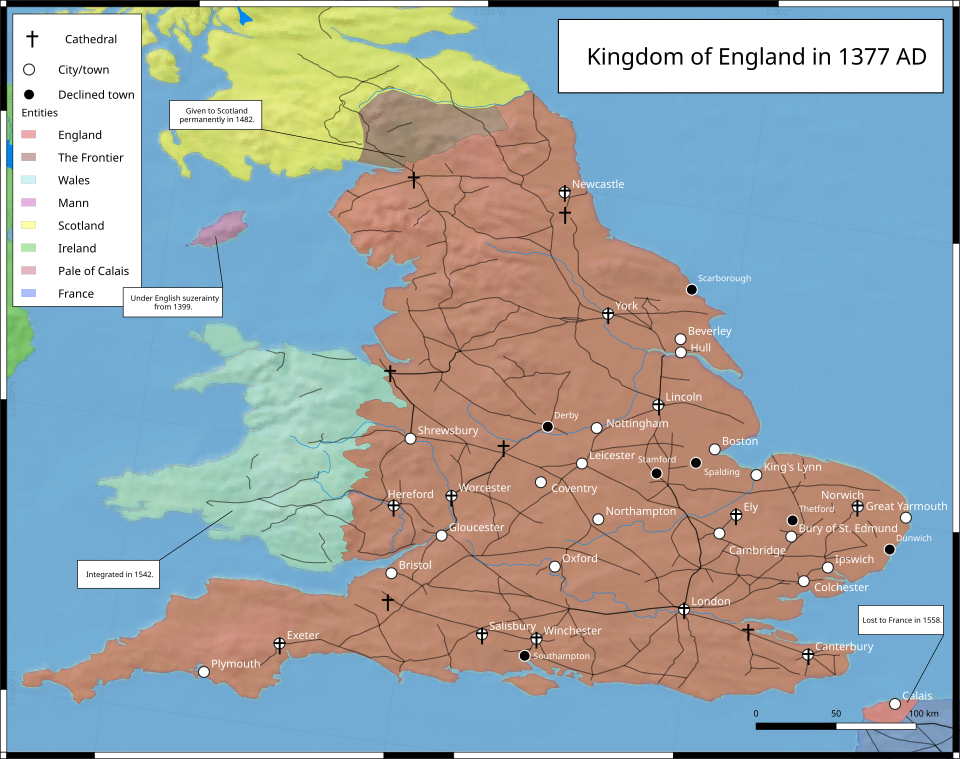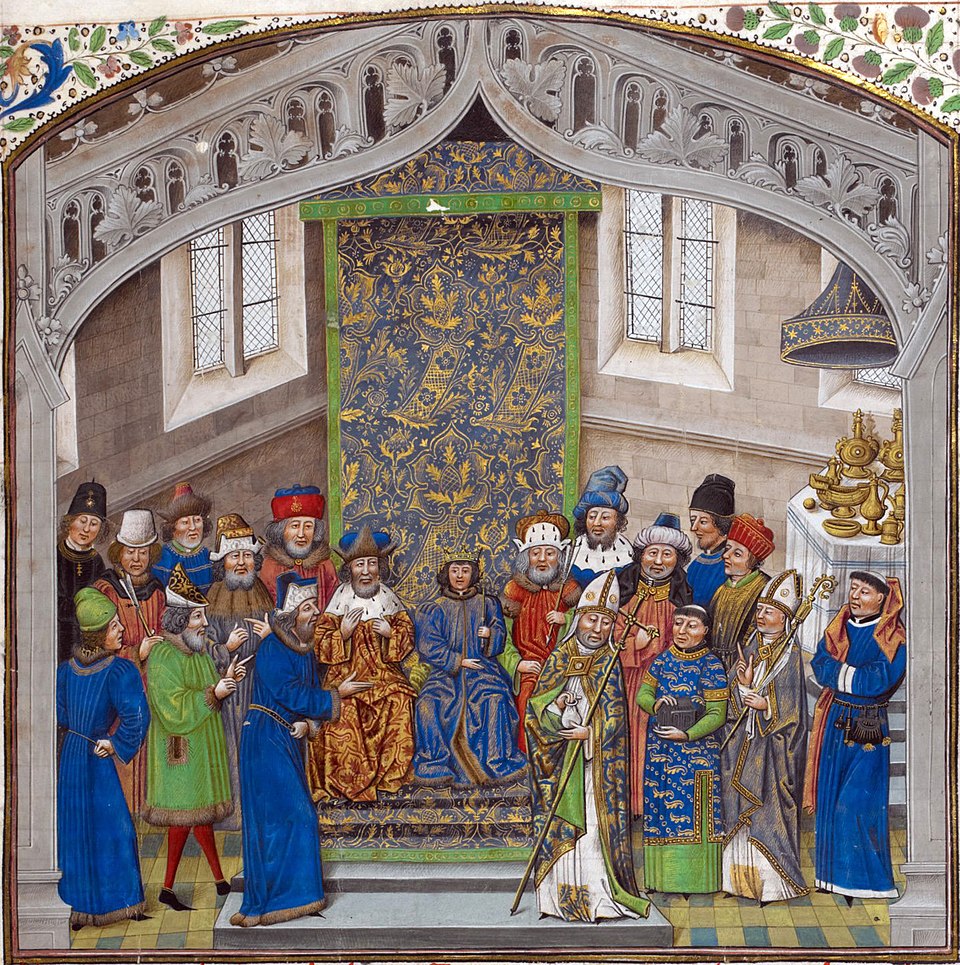OCR Specification focus:
‘England in 1377; Coronation of Richard II; Rule of the Councils.’
The minority government of Richard II marked a crucial transitional phase in late medieval England, defined by regency councils, financial difficulty, and competing aristocratic influence.
England in 1377
Richard II was crowned in June 1377, aged only ten, following the death of his grandfather, Edward III. His father, the Black Prince, had died the year before, leaving the young Richard as heir. England at this point faced several major challenges:
Ongoing Hundred Years’ War with France, draining royal finances.
Rising taxation pressures on the commons, fuelling discontent.
Outbreaks of plague and famine, causing economic disruption and population decline.
Growing influence of powerful magnates, particularly John of Gaunt, who was viewed with suspicion.

Map of England and its thirty largest cities in 1377. It helps students situate political authority, population centres, and logistical constraints relevant to taxation and governance under a minority government. Source
Minority Government: A form of rule where a monarch is underage and unable to govern independently, leading to the exercise of power by guardians or councils.
Although Richard was formally king, effective authority lay with others until he reached maturity. This reality shaped the fragile political order of his early reign.
The Coronation of Richard II
Richard’s coronation at Westminster Abbey was significant for reinforcing the sacred nature of kingship despite his minority. Important features included:
The anointing ceremony, which emphasised divine approval of his kingship.
Use of royal regalia to project continuity with Edward III.
Attendance of major nobles, projecting unity, though rivalry lurked beneath.

Illumination of Richard II enthroned immediately after his coronation, surrounded by bishops and courtiers. The image reinforces the sacral nature of kingship central to late-medieval coronations. Although produced later in the fifteenth century, it depicts the ritual context discussed in this subsubtopic. Source
The coronation helped to stabilise the regime symbolically. However, real political power had to be organised through institutions that could govern in Richard’s stead.
The Importance of Symbolism
Richard’s coronation deliberately emphasised monarchical legitimacy:
Ritual was used to elevate the boy-king above factional conflict.
It projected the image that Richard was God’s anointed ruler, despite his age.
The act reassured the commons and nobility that continuity of rule would prevail.
The Rule of the Councils
During Richard’s minority, the realm was governed by a series of Councils of Regency rather than by a single regent. Parliament had rejected John of Gaunt’s claim to sole authority, partly due to his unpopularity, and instead endorsed collective governance.
The First Councils
Key features of the councils included:
Composed of bishops, nobles, and royal officials, designed to balance rival interests.
Responsible for managing finances, law, and foreign policy.
Meant to act in the king’s name, preserving his authority.
This system reflected a desire to prevent the concentration of power in one magnate’s hands. The councils were, however, often inefficient and divided.
Tensions within the Councils
The councils had to navigate serious difficulties:
Financial crisis: Wars with France required funds, but taxation was deeply resented.
Factional rivalry: Magnates such as John of Gaunt and Thomas of Woodstock manoeuvred for influence.
Royal household expenditure: Maintaining the dignity of the monarchy was costly, exacerbating discontent in Parliament.
Council of Regency: A governing body established to rule in place of an underage monarch, consisting of leading nobles, clergy, and officials.
Although designed to preserve collective governance, the councils frequently became paralysed by factional disputes.
Relations with Parliament
Parliament played a crucial role in scrutinising the councils:
It granted taxation but expected accountability from councillors.
Criticism of mismanagement was frequent, particularly concerning military failures in France.
Councils had to justify their actions, creating tension between governance and parliamentary oversight.

Interior of the Chapter House, Westminster Abbey, an octagonal meeting space used for royal councils and, at points in the 1370s, sessions of the House of Commons. The image demonstrates the architectural setting for collective governance during Richard’s minority; decorative details visible are not required by the syllabus. Source
This early emphasis on parliamentary scrutiny would become a recurring feature of Richard’s reign.
Challenges Facing Minority Rule
The years 1377–1380 were marked by overlapping pressures:
Foreign policy: Ongoing campaigns in France drained resources and exposed weaknesses in leadership.
Domestic discontent: Commons grew increasingly hostile to taxation.
Religious debate: The teachings of John Wycliffe began to attract attention, though these developed more in the later 1370s.
The councils lacked the authority of a monarch acting personally, meaning their decisions often struggled to command respect.
Political Culture of the Minority
The minority government emphasised collective responsibility, but magnates often placed personal interests above national stability.
Patronage and offices were used to reward allies, sparking resentment among excluded groups.
Richard’s own upbringing at court was shaped by these dynamics, influencing his later views on kingship and authority.
Regency: The period during which a regent or council governs in place of a monarch who is underage, incapacitated, or absent.
Richard’s exposure to factional disputes during his minority shaped his later suspicion of magnates and his preference for personal rule.
The End of Minority Councils
By 1380, Richard II began to take a more active role, though still under significant influence from advisers. The councils gradually faded in importance as:
Richard developed his own concept of kingship, emphasising divine authority.
Tensions over taxation and war required more decisive leadership.
His circle of favourites, rather than collective councils, began to shape policy.
This transition marked the end of the minority period and set the stage for the personal rule of Richard II, with its own challenges and conflicts.
FAQ
John of Gaunt was viewed with suspicion because he was associated with excessive taxation and failures in the French war. Many believed he sought power for himself rather than serving the young king. His close involvement in unpopular financial decisions, and rumours that he might usurp the throne, further damaged his reputation.
The councils were deliberately structured to include senior clergy. Bishops provided administrative expertise, literacy, and legitimacy, ensuring decisions carried moral and religious weight.
Clerics such as Simon Sudbury, Archbishop of Canterbury, offered continuity of governance, balancing noble rivalries by presenting themselves as neutral, God-fearing statesmen.
The councils had limited funds and struggled to sustain effective campaigns. Their approach involved:
Raising taxation through parliamentary approval.
Attempting defensive measures to protect the southern coast from raids.
Negotiating truces when resources became overstretched.
Despite these measures, military setbacks in France and at sea heightened criticism of the councils’ competence.
England had past experiences where sole regents created instability. By spreading authority among nobles and clergy, Parliament hoped to:
Prevent one magnate, such as Gaunt, from dominating.
Encourage consensus decision-making.
Protect the young king’s prerogatives until he could rule personally.
This arrangement reflected a desire to uphold balance and reduce the risks of factional abuse of power.
Richard’s formative years exposed him to noble rivalry, criticism of councils, and Parliament’s interference. He witnessed councillors undermined and accused of mismanagement, which fostered his mistrust of magnates.
This experience encouraged his belief in personal monarchy, rooted in divine authority, and helps explain his later hostility to shared governance.
Practice Questions
Question 1 (2 marks)
In which year was Richard II crowned, and what immediate challenge faced England at that time?
Mark scheme:
1 mark for the correct year: 1377.
1 mark for identifying one challenge, e.g. ongoing war with France, financial strain, or social/economic problems such as plague and famine.
Question 2 (6 marks)
Explain two reasons why the Councils of Regency were established to govern during Richard II’s minority rather than granting sole authority to John of Gaunt.
Mark scheme:
Up to 3 marks per reason (maximum of 6 marks).
Award 1 mark for identifying the reason, 1 mark for contextual explanation, and 1 mark for demonstrating understanding of significance.
Acceptable answers include:
Distrust of John of Gaunt: He was unpopular with both the nobility and commons; granting him sole authority risked factional conflict. (1 mark for identification, 1 mark for explanation, 1 mark for significance).
Preference for collective governance: A council balanced the interests of bishops, nobles, and officials; intended to protect the authority of the monarchy and avoid over-concentration of power. (1 mark for identification, 1 mark for explanation, 1 mark for significance).
Other valid points may be credited if they are accurate, relevant, and demonstrate understanding.

